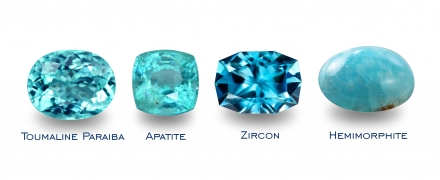open 10 am - 7 pm
laboratory is closed
Tourmaline PARAIBA "Refining and imitations"

The most common refining method for Paraiba tourmalines is heat treatment. It is produced with the aim of giving the stones a blue-green or blue color. Also, among the types of refinement, there is often the impregnation of open cracks and cavities in tourmalines with various compositions that improve the external perception of the quality of the stone. Adhesives are often used to prevent the destruction of low-quality stone during processing (cutting, cabochon, stone cutting). There are frequent cases of staining pale colored stones along cracks with colored filler. Techniques for diffusion staining of tourmaline are described in the literature, but there is no information on the commercial distribution of such a technique. In connection with the high prices for "paraiba", prevailing in the world market, very often you can find stones imitating tourmaline in color characteristics. The most common and easily recognizable imitations are zircon, apatite, cubic zirconia and even glass. Copper-bearing elbaites, which do not have an admixture of manganese, or even ordinary indigolites, are often given as "paraiba". Recently, they often try to sell hemimorphite under the guise of “paraiba”, which has nothing to do with the tourmaline supergroup. As a rule, hemimorphite has low purity characteristics and specific faceting, which makes it difficult to determine the optical character of the stone (axiality) and refractive index on a refractometer. Either bevelled stones with multiple polishing defects on the edges are used, or cabochon cut, which does not allow accurate reading of the refractive index values. For loose stones, an uncomplicated and reliable method of determination is to measure the specific gravity of the stone, since the differences between paraiba tourmaline and hemimorphite in this indicator are very significant. For fixed stones, the diagnostic method that gives the most accurate results is Raman spectroscopy, which allows you to quickly and accurately determine the mineral belonging of the stone.
В геммологической практике бывают весьма увлекательные случаи с диагностикой ювелирных вставок
Но помимо редкости цвета и высокой стоимости таких камней, многие розовые камни выделяются одной замечательной особенностью – они проявляют плеохроизм, то есть в зависимости от положения осмотра камня он может иметь дополнительные оттенки – оранжевый или пурпурный.
Currently, gemstones are produced by two fundamentally different technological methods - the High Pressure - High Temperature method (“HPHT”, High-pressure & High-temperature) and the Chemical Vapor Deposition (“CVD”, Chemical vapor deposition) method. The "HPHT" method is the most tested classical synthesis method, which can be used both carbon deposition on diamond from flux melts and catalytic reactions. In "CVD" synthesis, diamond growth occurs on a seed during carbon deposition mainly from a gaseous medium at relatively low temperatures and pressures.
Jewelry and precious stones are just such a category of goods, when buying which you need to pay attention to many criteria.
Sogdianite is a rather rare mineral and more often it can be found as a collection material (moreover, in systematic collections), and it is extremely rare in jewelry.






